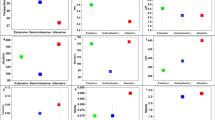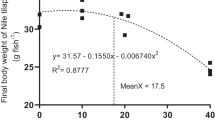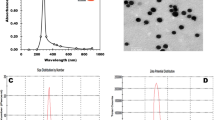Abstract
During a subchronic toxicity and reproduction study with tri-n-butyltin oxide (TBTO) concentrations of 0, 24, 60, and 150 mg/kg diet in Japanese quail, preliminary data on hematology and serum biochemistry were obtained. The absence of serious effects in blood parameters in both adult quail and developing chicks are discussed in view of the adverse effects of TBTO on reproduction.
Similar content being viewed by others
References
Alzieu C (1991) Environmental problems caused by TBT in France: Assessment, Regulations, Prospects. Mar Environ Res 32:7–18
Boyer IJ (1989) Toxicity of dibutyltin, tributyltin and other organotin compounds to humans and to experimental animals. Toxicology 55:253–298
Coenen TMM, Brouwer A, Enninga IC, Koeman JH (1992) Subchronic toxicity and reproduction effects of tri-n-butyltin oxide in Japanese quail. Arch Environ Contam Toxicol 23:457–463
Crofton KM, Dean KF, Boncek VM, Rosen MB, Sheets LP, Chernoff N, Reiter LW (1989) Prenatal or postnatal exposure to Bis(tri-n-butyltin)oxide in the rat: postnatal evaluation of teratology and behaviour. Toxicol Appl Pharmacol 97:113–123
Duncan J (1980) The toxicology of molluscicides: The organotins. Pharmacol Ther 10:407–429
Dunnett CW (1955) A multiple comparison procedure for comparing several treatments with a control. J Am Stat Assoc 50:1096–1121
Edens FW, Garlich JD (1982) Lead-induced egg production decrease in leghorn and Japanese quail hens. Poult Sci 62:1757–1763
Fent K, Hunn J, Renggli D, Siegrist H (1991) Fate of tributyl-tin in sewage sludge treatment. Mar Environ Res 32:223–232
Fleming WJ, Hill EF, Momot JJ, Pang VF (1991) Toxicity of trimethyltin and triethyltin to mallard ducklings. Environ Toxicol Chem 10:255–260
Gilbertson M, Kubiak T, Ludwig J, Fox G (1991) Great lakes embryo mortality, edema, and deformities syndrome (GLEMEDS) in colonial fish-eating birds: Similarity to chick edema disease. J Toxicol Environ Health 33:455–520
Gressnerova S (1987) Hematological characteristics of Japanese quails (Coturnix coturnix japonica) following treatment with the fungicide trimorfamid. Acta Fac Rerum Nat Univ Comenianae Zool 30:35–42
Guta-Socaciu C, Giurgea R (1989) Metabolic disturbances induced by organotins through subchronic treatment in chickens, Second communication: Mineral metabolism. Arch Exp Veterinarmed 43(3):421–425
Schlatterer B, Coenen TMM, Ebert E, Grau R, Hilbig V, Munk R (1993) Effects of bis-(tri-n-butyltin)oxide in Japanese quail exposed during egg laying period: An interlaboratory comparison study. Arch Environ Contam Toxicol 24:440–448
Snoeij NJ, Penninks AH, Seinen W (1987) Triorganotin compounds in immunotoxicology and biochemistry, Snoeij NJ, Thesis, University of Utrecht, The Netherlands, pp 55–71
Szubartowska E, Gromysz-Kalkowska K, Stepien M (1991) Stilbestrol as a factor modifying the toxicity of Etakin for the Pharaoh quail (Coturnix coturnix Pharaoh) I. Young birds. Comp Biochem Physiol C 100(3):597–602
Vos JG, De Klerk A, Krajnc EI, van Loveren H, Rozing J (1990) Immunotoxicity of Bis(tri-n-butyltin)oxide in the rat: Effects on thymus dependent immunity and on nonspecific resistance following long-term exposure in young versus aged rats. Toxicol Appl Pharmacol 105:144–155
Walker CH (1990) Review. Persistent pollutants in fish-eating sea birds—bioaccumulation, metabolism and effects, Aqua Toxicol 17:293–324
Wester PW, Krajnc EI, van Leeuwen FXR, Loeber JG, van der Heijden CA, Vaessen HAMG, Helleman PW (1990) Chronic toxicity and carcinogenicity of bis(tri-n-butyltin) oxide (TBTO) in the rat. Fd Chem Toxicol 28:179–196
Yoshizuka M, Hara K, Haramaki N, Yokoyama M, Mori N, Doi Y, Kawahara A, Fujimoto S (1992) Studies on the hepatotoxicity induced by bistributyltin oxide. Arch Toxicol 66(3):182–187
Author information
Authors and Affiliations
Rights and permissions
About this article
Cite this article
Coenen, T.M.M., Enninga, I.C., Cave, D.A. et al. Hematology and serum biochemistry of Japanese quail fed dietary tri-n-butyltin oxide during reproduction. Arch. Environ. Contam. Toxicol. 26, 227–233 (1994). https://doi.org/10.1007/BF00224809
Received:
Revised:
Issue Date:
DOI: https://doi.org/10.1007/BF00224809




